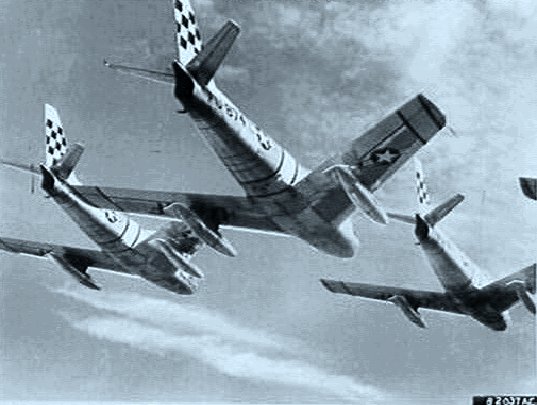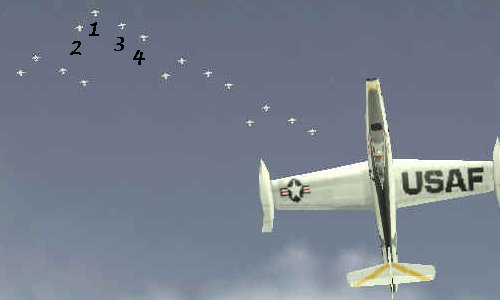
MiG Alley
Formation Flight
The aircraft in MiG Alley use the classic "Finger Four" formation. This was known to Commonwealth pilots (Canadian and Australian) as "High Battle Formation".
Number 1 and 2 comprised the first element, No.3 and 4 the second.
Number 1 in the formation was at the front, naturally.
No. 2 flew at his 8 o'clock position. No.3 flew at No.1's 4 o'clock position and No.4 at No.3's 4 o'clock.
Simple!

From the reference material included with the sim.
According to Christie Harris, who flew for the RCAF in the 1950's, "You started as a wingman, with three practically foolproof opportunities for disaster.
The first was hanging on to your lead's wing. Flying formation is no cinch at any time. It's especially no cinch while the flight is performing a turn at high altitude. Just let your nose drop a little then. Just lose a little altitude, get compressibility effects, lose Mach; and you've got troubles.
At 40,000 feet or above you just cannot regain your Mach and get back to that 4 o'clock position. And you sure are not going to win any points for straggling.
The second is keep your head on a swivel!" No matter what your flying problems are at the monment, maintaining a sharp lookout, particularly over your own cone of responsibility in the flight's 360 degree coverage. Clear the 6 o'clock position. See that nobody actually sneaks up behind the formation. And actually sharpen that lookout during a turn when the flight is most vulnerable to attack, even though that just happens to be the time when you are most vulnerable to Mach buffet and other little joys.
Then, in case you are not busy enough already, navigate. Your flight could be scattered by attack. You could find yourself alone in that big sky with a rapidly dwindling fuel supply. it might be awfully nice to know where you are!"
FROM "Let X be Excitement" by Christie Harris
(Out of print)

Four groups of F-80 Shooting Stars in finger 4 formation.
These screenshots were taken on a Pentium 233MMX using a Creative 3D Blaster Banshee graphics card.
